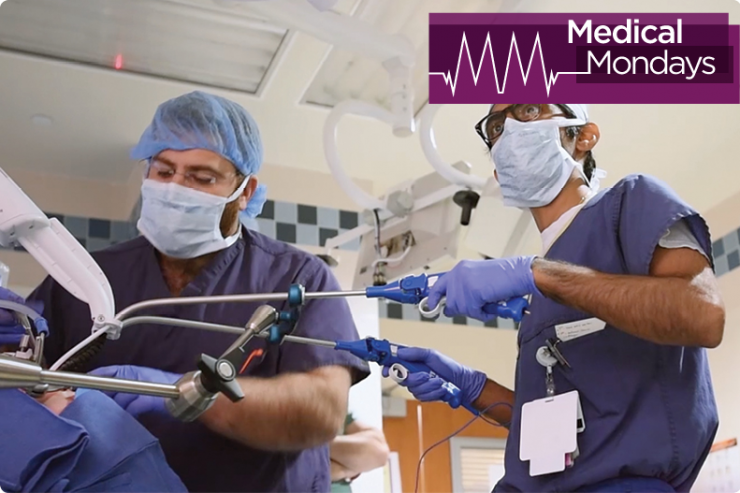If surgery is in your future, you may wonder what the experience will be like. You may worry that you’ll need to take a lot of time away from work or other activities to recover. You may also have concerns about potential complications or scarring.
No surgery is without some risk, and recovery time can vary in each person. But new advancements in technology and techniques have made many surgeries safer than ever. One such advancement is robotic surgery, also known as robot-assisted surgery.
What Is Robotic Surgery?
In robot-assisted surgery, surgeons operate using a computerized system that employs robotic arms. Using this technology, your surgeon can:
- View magnified and 3D (three-dimensional) images of the part of your body on which they’re performing surgery.
- Make smaller cuts (incisions) to access the area.
- Perform precise movements with tiny surgical instruments.
Does a Robot Perform Robotic Surgery?
The short answer is no. While robotic surgery relies on a computer-assisted surgical system, your surgeon remains in charge the whole time. During robotic surgery, your surgeon controls each movement the robotic arms make.
Depending on the type of robot-assisted system your surgeon uses, it may include a:
- Console. This is the command center of the robotic surgery system. Your surgeon sits at the console during surgery to view the surgical area. They control every movement of the robotic arms and surgical instruments from the console.
- Bedside cart. This cart holds the system’s robotic arms and surgical instruments. It also includes a high-definition 3D camera that allows your surgeon to see a highly detailed view of the surgical area.
- Extra cart. The robot-assisted surgical system may also include a cart that holds equipment for suction, irrigation, and lighting.
Never Miss a Beat!
Subscribe to Our HealthBeat Newsletter!
Thank you for subscribing!
You can now select the specific newsletters you'd like to receive.
You are already subscribed.
Subscribe to more newsletters in our email preference center.
Sorry, an error occurred. Please try again later.
Get Healthy Tips Sent to Your Phone!
Are All Surgeries Robotic Now?
While doctors may use robotic surgery for many conditions, the technology isn’t right for every surgery. The FDA has approved the use of robot-assisted surgery for certain types of surgery. Talk to your doctor to see if robotic surgery is right for your upcoming surgery.
Can Any Surgeon Perform Robotic Surgery?
Surgeons who perform robotic surgery must be specially trained to use the equipment. Besides training in their medical specialty, surgeons also learn how to use robot-assisted systems.
When Do Surgeons Use Robot-Assisted Systems?
Surgeons may use robotic surgery to access hard-to-reach areas in your body. They also use robot-assisted techniques to perform complex procedures.
Your surgeon may use a robotic system for:
- Bariatric (weight loss) surgery.
- Cardiac surgery.
- Colon and rectal surgery.
- General surgery.
- Gynecologic surgery.
- Head and neck surgery.
- Kidney and adrenal surgery.
- Liver, pancreas, and gallbladder surgery.
- Prostate and pelvic surgery.
- Thoracic surgery.
- Thyroid surgery.
- Urological surgery.
What Happens During Robotic Surgery?
An anesthesiologist will give you general anesthesia before robotic surgery begins, so you won’t feel any pain or know what’s happening. Once you’re asleep, your surgeon will:
- Make any necessary incisions and insert the surgical instruments.
- Position the high-definition camera to view the surgical area.
- Use the computer console to control the robotic arms and surgical instruments.
What Are the Benefits of Robotic Surgery?
During robotic surgery, your surgeon uses a computer to control the robotic arms. Your surgeon can move the robotic arms in ways they may not be able to move their own hands. This allows your surgeon to complete surgical procedures with tiny, precise movements.
Robot-assisted surgery offers several benefits. These include:
Smaller incisions
Smaller incisions mean you’re more likely to recover faster after surgery. There’s typically less bleeding during robotic surgery than in traditional (open) surgery. You may also have less pain as you heal.
Lower infection risk
With the smaller incisions typically used during robotic surgery, the surgical area is smaller. This means you have less exposure to germs that may cause infection.
Less scarring
With open surgery, scars tend to be larger when the area heals. When your surgeon makes small incisions during robotic surgery, any scars you have will usually be smaller.
Reduced hospital time
Faster recovery after robotic surgery means you’ll typically spend less time in the hospital. Going home sooner reduces your risk of hospital-acquired infections. Being at home can also make recovery more comfortable.
Does Robotic Surgery Have Any Risks?
Any type of surgery has risks, including robotic surgery. Potential risks from any surgery — robotic or not — include:
- Bad reaction to anesthesia.
- Trouble breathing.
- Bleeding or blood clots.
- Infection.
There are also some specific risks related to robot-assisted surgery. These include the potential for equipment failure and the need for your surgeon to switch to open surgery under certain conditions. If you have concerns about potential risks specific to robotic surgery, talk to your surgeon.
How Should I Prepare for Robotic Surgery?
Before robotic surgery, your doctor will give you instructions about:
- When to arrive at the hospital.
- When you need to stop eating and drinking.
- Whether you should take any medications you typically take.
What Is Recovery Like After Robotic Surgery?
Once your surgeon has finished the procedure, they close your incisions. Your care team takes you to a recovery room while your anesthesia wears off. They monitor your breathing, blood pressure, and heart rate.
When you’re awake, you’ll move to a hospital room. Your doctor will tell you when you can go home and what you can expect during your recovery. Follow your doctor’s instructions about when you can safely:
- Go back to work.
- Drive.
- Lift children or heavy objects.
- Exercise at home or return to the gym.
Is Robotic Surgery Right for Me?
Robotic surgery has become more common, with these advanced techniques now available at hospitals in your community. But robotic surgery may not be right for you if you have:
- A complex medical condition.
- More than one chronic health condition (comorbidities).
Talk to your doctor about whether robotic surgery is right for you.
Editor's Note: This article was originally published on , and was last reviewed on .
You might also like…
About UPMC
Headquartered in Pittsburgh, UPMC is a world-renowned health care provider and insurer. We operate 40 hospitals and 800 doctors’ offices and outpatient centers, with locations throughout Pennsylvania, Maryland, New York, West Virginia, and internationally. We employ 4,900 physicians, and we are leaders in clinical care, groundbreaking research, and treatment breakthroughs. U.S. News & World Report consistently ranks UPMC Presbyterian Shadyside as one of the nation’s best hospitals in many specialties and ranks UPMC Children’s Hospital of Pittsburgh on its Honor Roll of America’s Best Children’s Hospitals. We are dedicated to providing Life Changing Medicine to our communities.




